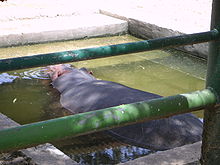Qalqilya Zoo
| Qalqilya Zoo | |
|---|---|
 | |
 | |
| 32°11′43″N 34°58′15″E / 32.1953845°N 34.9707511°E | |
| Date opened | 1986[1] |
| Location | Qalqilya, West Bank, Palestine |
| Land area | 2 hectares (4.9 acres) |
| No. of animals | 170 |
Qalqilya Zoo (Arabic: حديقة الحيوانات الوطنية) is a small 2-hectare (4.9-acre) zoo in the Palestinian city of Qalqilya on the western edge of the West Bank.[2][3] Established in 1986, it is the only zoo in the State of Palestine.[1] The zoo houses 170 animals, a small Natural History museum, a children's entertainment park, and on-site restaurants.
History

The zoo was the brainchild of the former mayor of Qalqilya. Israeli zoos helped to stock it and it was designed as a symbol of Arab-Israeli cooperation.[4] When it opened in 1986, the zoo was considered a "jewel in the crown of Palestinian national institutions."[1] It became a popular attraction and was later expanded to accommodate the increasing flow of visitors,[6] which included both Arabs and Israelis.[7]
After the outbreak of the Second Intifada, visitors from outside Qalqilya were barred entry. In 2003, the Israeli authorities allowed group visits arranged in advance.[4] A child playing outside the main entrance of the zoo on a public holiday was killed by indiscriminate fire which led to a brief drop in visitors.[6] The zoo's survival has been attributed to the hard work and dedication of its resident veterinarian, Sami Khadr, and his staff.[6]
During the intifada, "Dubi", the zoo's only male giraffe, from South Africa, frightened by the sound of gunfire, was killed when it ran into a pole.[3] "Ruti", his pregnant partner, miscarried ten days later.[1] Both animals can now be seen stuffed at the zoo's museum.[5] In 2002, three zebras died after inhaling tear gas used to break up a demonstration at a high school adjacent to the zoo.[8] Mr. Khadr applied taxidermy to preserve some of the animals, including the giraffe, the unborn calf, the zebras, a monkey, wildcats and snakes.[1]
Since its inception, an Israeli veterinarian, Motke Levison, has helped out at the zoo, providing phone consultations and meeting with Khadr to deliver emergency medical supplies. Levison has served as a mediator, helping the zoo acquire new animals.[1] Three lions, three ibex desert goats and two zebras were donated by the Ramat Gan Safari park in September 2004.[8] The lions were meant to be transferred to Qalqilya in 2000, but the outbreak of the Second Intifada delayed the delivery.[9] Saeed Daoud, director of the Qalqilya Zoo, dubbed the three lions, who were named Jafer, Jaras and Naboko, "the kings of peace."[10] According to Khadr, the Ramat Gan zoo also sent him monkeys, an ostrich, and raccoons.[9]
Zoo grounds

The zoo houses lions, brown bears, crocodiles, ostriches, camels, deer, gazelles, zebras, birds, lizards, snakes, and monkeys of various types.[2] There is also a hippopotamus named Dubi, who shares his small concrete wading pool with a family of peacocks.[3] In December 2003, the zoo was described in The Guardian as "one of the West Bank's more pleasant surprises [...] there is a small but beautiful landscaped park. [...] And amid the trees, in spacious, clean enclosures, a lioness, an ostrich, a family of bears, a pool full of crocodiles."[6] The animals have ample room to move around with some enclosures as big as those in the London Zoo.[4]
The zoo can be reached by taking a service taxi from the city center. The zoo also has a children's entertainment park, part of which is inside what used to be a swimming pool.[2][4]
Museum
After their deaths, animals from the zoo have been taxidermized by the resident veterinarian, a self-taught taxidermist.[5] School children are frequent visitors to the zoo's "colorful, highly eccentric Natural History Museum."[3] Almost 100 exotic animals are displayed in it.[5]
See also
References
- ^ a b c d e f Julia Glover (August 5, 2004). "Zebras, giraffes and tear gas". CBC News. Retrieved 2009-01-25.
- ^ a b c "Contrasts in the Zoo of Palestine". Palestine Monitor. February 14, 2008. Archived from the original on 2015-09-24. Retrieved 2009-01-25.
- ^ a b c d Thomas, Amelia (2008-07-08). "The last Palestinian zoo". Lonely Planet. Retrieved 2022-07-30.
- ^ a b c d e "West Bank zoo stays open, but one by one its animals are dying amid". The Independent. 2003-07-25. Retrieved 2022-07-30.
- ^ a b c d "This Palestinian Taxidermist's Stuffed Animal Zoo Is Heartbreaking". www.vice.com. Retrieved 2022-07-30.
- ^ a b c d "The world's loneliest zoo". The Independent. 2003-12-14. Retrieved 2022-07-30.
- ^ Justin Huggler (July 26, 2003). "West Bank zoo stays open, but one by one its animals are dying amid the teargas and panic". The Guardian. London. Retrieved 2009-01-25.
- ^ a b Laurie Copans (September 10, 2004). "Israeli lions and zebras make new home in Palestinian zoo". JWeekly. Retrieved 2009-01-25.
- ^ a b VIva Press NULL (September 12, 2004). "Israel sends animals to Palestinian zoo in gesture of cooperation". Israel 21c. Retrieved 2009-01-25.
- ^ Ahmad Sub Laban (September 22, 2004). "The lion kings of Qalqilya". Archived from the original on September 24, 2015. Retrieved 2009-01-25.
